Evaluation of the Student Work Placement Program
From: Employment and Social Development Canada
On this page
Alternate formats

Evaluation of the Student Work Placement Program [PDF - 2.1 MB]
Request other formats online or call 1 800 O-Canada (1-800-622-6232). If you use a teletypewriter (TTY), call 1-800-926-9105. Large print, braille, audio cassette, audio CD, e-text diskette, e-text CD and DAISY are available on demand.
List of figures
Figure 1. Student Work Placement Program Timeline (March 2016 to August 2020)
Figure 2. Number of work-integrated learning opportunities from 2017 and 2018 to 2019 and 2020
Figure 3. National average distribution of work-integrated learning opportunities from 2017 and 2018 to 2018 and 2019
Figure 4. National distribution of work-integrated learning opportunities in 2019 and 2020
Figure 5. Distribution of students who had work-integrated learning opportunities by post-secondary program from 2017 and 2018 to 2019 and 2020
Figure 6. Distribution of students who had work-integrated learning opportunities by age group from 2017and 2018 to 2019 and 2020
Figure 7. Distribution of female and male students by sector of activity from 2017 and 2018 to 2019 and 2020
Figure 8. Proportions of students who identified as being from under-represented groups, from 2017 and 2018 to 2019 and 2020
Figure 9. Percentage of students who indicated that the program’s work placement helped them improve specific work related skills
Figure 10. Proportion of employers who indicated that the program’s work placement helped students improve their work related skills and abilities in the following areas
Figure 11. Number of partnerships, with unique employers, from 2017 and 2018 to 2019 and 2020
Figure 12. Distribution of partnerships with employers, based on company size, from 2017 and 2018 to 2019 and 2020
Figure 13. Proportion of employers who would have offered a work placement without the program’s funding
Figure 14. Non-financial challenges to offering work placements as identified by employers
Figure 15. Students’ level of satisfaction with the program’s work placements
Figure 16. Employers’ level of satisfaction with students’ performance during the program’s work placements
Figure 17. Employers’ level of satisfaction with the application process and administration
Figure 18. Proportion of employers who would consider hiring students on a long term basis
1. Executive summary
Introduction
The Student Work Placement Program provides wage-subsidies to employers, across Canada, to create work-integrated learning opportunities for post-secondary students. The program is funded by Employment and Social Development Canada (ESDC) and it is delivered by a selection of third party organizations. The program’s Logic Model is included in Annex A. Additionally, ESDC’s Performance Measurement and Evaluation Committee approved the evaluation questions, attached in Annex B, and the Evaluability Assessment in September 2020.
This formative evaluation (Phase I) has been conducted in the early stages of the program delivery and has examined the program’s relevance, initial design, delivery features and early achievements. It covers the period from program’s inception in 2017 to August 2020. Phase II will be conducted in 2023 and 2024 and will examine the longer term impacts of the program. The details of the lines of evidence used for this evaluation, including their limitations as well as the evaluation’s methodology, can be found in Annex C.
The following sections identify the key findings from the evaluation and the associated recommendations.
Key findings summary
- There is an ongoing need for the Student Work Placement Program to support a better alignment between the skills of post-secondary students and the evolving needs of employers in Canada. Moreover, employers want the program to become permanent
- The program created 11,952 work-integrated learning opportunities during the evaluation period and filled a program gap through its unique design and delivery features. In fact, the large majority of students and employers were satisfied or very satisfied with the program. However, the onboarding and supervision of new students as well as the additional administration were perceived as an added burden by employers
- The large majority of students and employers reported that students’ participation in the program resulted in the improvement in their work ready skills, including critical-thinking, oral communication, problem solving skills and time management
- As a result of participating in the program, the majority of employers would consider using work placements in the future as well as hiring some of the program’s placement students on a long-term basis. In fact, 36% of the students who were interviewed had been offered a job in their field while 20% of employers were undecided or would not hire students on a long-term basis
- All of the stakeholders were satisfied with the program’s design and delivery features regarding wages, subsidies and the COVID-19 temporary measures. They also identified multi-year agreements as a strength that facilitated ongoing relationships and long-term planning. However, some students, employers and post-secondary institutions reported challenges with the application process and had limited awareness of training opportunities
- The “net new” requirement and the ineligibility of international students were considered to be program design limitations by both employers and funding recipients. The “net new” meant that all new work placements were required to be additional to those offered in the year prior to receiving program funding
Recommendations
- Improve program awareness and understanding, amongst students, employers and post-secondary institutions across Canada
- Encourage the development of “work-ready” training opportunities, which are available to participants, as a complement to their work placement experiences
- Increase program accessibility by continuing to address official language gaps related to communications and documentation
- Consider addressing the suggestions from employers and funding recipients to permanently remove the “net new” requirement for employers
- Ensure accurate and comprehensive collection, entry and reporting of data by providing operational definitions of program variables (for example: age, sex and gender, program and field of study, duration of placement and earnings) as well as technical support including standardized procedures
2. Program background
The Student Work Placement Program supports the creation of work-integrated learning opportunities for post-secondary students of all ages. They include co-op placements, internships, field placements, or applied projects and can vary in intensity, location and duration.
"Work-integrated learning is a model and process of curricular experiential education which formally and intentionally integrates a student’s academic studies within a workplace or practice setting and includes an engaged partnership of an academic institution, a host organization and a student"
(Co-operative Education and Work-Integrated Learning Canada. 2020).
At the time of the evaluation, the program was based on contribution agreements with eleven third-party organizations, known as funding recipientsFootnote 1, from different sectors of the economy. These funding recipients were to:
- provide wage subsidies to employers that offered quality work-integrated learning opportunities
- create partnerships between employers and post-secondary institutions to develop new work placements
- better align the post-secondary skills training with the needs of employers across Canada
The funding recipients were well established in providing evidence-based labour market information, training and talent programs to support vital sectors of the Canadian economy such as: aviation, biotechnology, environmental, electricity, information and communication technology, mining, entrepreneurship and finance. Funding has increased incrementally over its lifespan (Figure 1).

Figure 1. Text version:
March 2016
- Budget 2016: $73 million over 4 years for up to 9,000 work-integrated learning opportunities in science, technology, engineering and mathematics (STEM) and business programs
May 2017
- Launch of the Student Work Placement Program
- Beginning of the evaluation period, Phase I
March 2018
- Budget 2018: $8.3 million over 3 years for 1,000 work-integrated learning opportunities in cyber-security
June 2018
- G7 Announcement: $3 million over 3 years for 500 work-integrated learning opportunities in artificial Intelligence
March 2019
- Budget 2019: $631.2 million over 5 years for up to 20,000 work-integrated learning opportunities per year in all disciplines, by 2021 and 2022
April 2020
- $80 million to support the creation of up to 20,000 placements, including 5,000 new work-integrated learning opportunities in health care and other front line sectors, and to increase the wage subsidy for all placements in 2020 and 2021
June 2020
- COVID-19 Emergency Response Plan: $186.1 million for 20,000 work-integrated learning opportunities in high-demand sectors, for a total up to 40,000 work placements in 2020 and 2021
August 2020
- End of Evaluation Period (Phase I)
During the evaluation period, from April 2017 to August 2020, the program expanded its scope and also added temporary measures to respond to COVID-19 related challenges. The design features below capture the program’s eligibility criteria, wage subsidies as well as the COVID 19 temporary measures.
2.1 Student eligibility
Students of all ages who are enrolled in post-secondary education institutions in Canada and are:
- Canadian citizens, permanent residents, or persons to whom refugee protection has been conferred under the Immigration and Refugee Protection Act
- legally entitled to work in Canada in accordance with relevant provincial or territorial legislation and regulations
When the program was launched in 2017 and 2018, the target population was students studying in science, technology, engineering, and mathematics and business programs. Starting in 2019 and 2020, the program expanded to include students from all disciplines.
2.2 Employer eligibility and subsidies
Employers that were served by the funding recipients and that were able to provide relevant work placements to post-secondary students. They received:
- 50% of the wage cost (up to a maximum of $5,000) for a standard placement
- 70% of the wage cost (up to a maximum of $7,000) for placements for first year students and under-represented groups
Small and medium-sized enterprises were specifically encouraged to apply.
2.3 COVID 19 Emergency response plan
In early 2020, notable changes to the program in response to COVID-19 were implemented and included:
- an increase in the amount of wage subsidies to 75% (up to a maximum of $7,500) for all program work placements
- the removal of the “net new” placement criteria, which required employers to ensure that all program work placements were additional to the number of work placements the employer offered in the year prior to receiving program funding
- allowing remote work placements and placement durations of less than twelve weeks
- allowing post-secondary institutions to qualify as eligible employers
3. Key findings
3.1 Program relevance
Key finding #1
There is an ongoing need for the Student Work Placement Program to support a better alignment between the skills of post-secondary students and the evolving needs of employers in Canada.
The 2018 report of the Standing Committee on Human Resources, Skills and Social Development and the Status of Persons with Disabilities recommended that the Government of Canada, and specifically the program, expand the opportunities available to Canadians for experiential learning. Additionally, the Horizontal Review of Skills Programming (2019) made a recommendation to Treasury Board to expand the program to include students from all disciplines.
Recent studies demonstrate that the central role of work-integrated learning opportunities is to better prepare students for the workforce. For example, the Business Higher Education Roundtable (2019) considers work placements to be the “most efficient and effective way to prepare Canada’s youth for the coming skills revolution.” Further, an emphasis on soft skills and skills necessary to finding employment was deemed necessary by the Canadian Federation of Independent Businesses (2018).
The Royal Bank of Canada (2018) asserts that these types of skills will be important for virtually 100 percent of job openings, across all industries and that work-integrated learning programs are the only way for candidates to develop these skills.
Students’ needs
In a recent study, students perceived a gap between the skills they are developing at university or college and the skills they need for their future careers. The largest gaps were in soft skills including leadership, teamwork and creative and innovative thinking skills. Participants, in the same study, affirmed that there is also a gap between skills resulting from post-secondary education and those required for successful employment (Lenarcic Bliss, D. and Pichette, J. 2018).
According to an Abacus Data survey (2016), 89% of both current and former students supported more work-integrated learning opportunities in their academic programs. In fact, graduates who had work placements, as part of their studies, believed they were better prepared with work-ready skills than graduates who did not have any work placement experience. In addition, 47% of these participants believed there were not enough of these opportunities for students.
Despite investments made towards work-integrated learning, according to the Business-Higher Education Roundtable (2019), 40% of post-secondary students did not have the opportunity to participate in such a work placement.
Employers’ needs
A 2019 survey, of 86 leading Canadian organizations, revealed that employers believed it was challenging to find employees with the right technical skills as well as the more “human” soft skills, including collaboration, teamwork and interpersonal skills. They were also interested in building stronger relationships with post-secondary institutions, resulting in partnerships that would contribute to preparing students for meeting the needs of the future work place (Business Council of Canada, 2020).
Key finding #2
The Student Work Placement Program addresses the needs of participating employers and students and also fills a program gap through its unique design and delivery features. Moreover, employers want the program to become permanent.
Stakeholder needs
All of the employers, who were interviewed, revealed that their ability to hire more students was attributed to the program’s wage subsidies. Several of them also highlighted the importance of making the program permanent to allow for better planning of work placement opportunities and human resource management.
All of these employers, as well as those who participated in the exit surveys, reported that program’s work-integrated learning opportunities made important contributions to addressing their company’s needs.
All of the funding recipients, who were interviewed, emphasized the positive contribution of the program in addressing labour shortages in some sectors (for example: mining, electricity) as well as feeding into the talent pool of other sectors.
Interviews with both students and funding recipients as well as student exit surveys confirmed that the program’s work-integrated learning opportunities addressed students’ needs related to:
- learning and improving new skills
- understanding early work-related expectations
- deciding on a career path
- making linkages between theory and practice
Unique design and delivery features
A comparison with 14 other federal work placements programs (Annex D) revealed that the program is addressing gaps left by other federally funded programs through unique design and delivery features. These features include:
- focusing on creating multi-stakeholder partnerships between employers and post-secondary institutions across Canada
- funding recipients offering training on work-ready skills that complement those offered by employers and post-secondary training
- unrestricted participant age and eligibility which allows participation from all disciplines including both full and part-time post-secondary enrollment status
3.2 Delivery partner model
Key finding #3
The third party delivery model supported employers’ creation of work-integrated learning opportunities and created partnerships with small and medium-sized enterprises.
Case studies and interviews with funding recipients revealed that leveraging of existing partnerships as well as the creation of new collaborations with and between post-secondary institutions and employers was pan-Canadian and ongoing.
Funding recipients reported that the program contributed to increasing access to work-integrated learning opportunities for small enterprises. In fact, in many of the program’s sectors, small and medium-sized enterprises are predominant.
In some cases, funding recipients “educated” the small enterprises that had not had experience hiring students. In fact, some small and medium-sized employers would have never hired students without the wage-subsidy provided by the program. For example:
- Venture for Canada is focused on fostering an entrepreneurial mindset, and is largely dedicated to creating partnerships with small and medium enterprises. About 60% of their employers had never previously hired an intern. As such, they gradually increased their capacity to offer work placements by building relationships with leaders in the field, identifying gaps by talking with them and explaining the program
- Mining Industry Human Resources Council serves a sector dominated by large enterprises, but made significant efforts to engage with small and medium employers. This was done by reaching out to new industry stakeholders who did not have the same culture of work-integrated learning as larger enterprises. Discussions occurred about the benefits of the program and resulted in increased dialogue with post-secondary institutions
- Electricity Human Resources Canada created relationships with small and medium employers in regional locations based on the advice of their national steering committee and on feedback from educators and employers. To support these enterprises, the funding recipient implemented a 30 day pre-approval application process. This process allowed small and medium-sized employers to have program work placements approved, within 30 days of applying, pending their ability to find an eligible candidate. This supported an increase in the number of partnerships with small and medium employers
Key finding #4
Funding recipients designed and implemented specific delivery features to promote program awareness and outreach. However, some challenges were noted related to navigating through certain webpages.
Outreach and communication campaigns
Case studies showed that the large majority of funding recipients designed and implemented extensive marketing and communication activities to reach students, employers and post-secondary institutions.
These included traditional and social media campaigns, newsletters and numerous outreach events. Such events included:
- information sharing sessions
- webinars and seminars
- presentations
- speaking engagements and workshops (often as part of national conferences and summits)
National steering committees
Document reviews noted that several funding recipients created national steering committees formed by industry and post-secondary institutions:
- their role was to increase outreach and awareness of the program as well as to foster partnerships between post-secondary institutions and employers
- they also helped with obtaining up-to-date information on the needs of employers, students and post-secondary institutions and provided direction on curriculum development
Webpages dedicated to program funded projects
Case studies revealed that funding recipients created webpages dedicated to projects funded by the program. Some of them also developed extensive FAQs, application guides for students and employers as well as created dedicated program portals.
Case studies also revealed that the majority of these webpages were generally user-friendly. Information about the program, for students and employers, was usually easy to locate. However, on a few webpages, locating specific program information was not always intuitive and some of the information on the eligibility criteria and target populations was inconsistent.
Additionally, case studies discovered that dedicated program webpages are generally bilingual. However, in some cases, not all of their relevant program information is available in French.
It was also noted, through the case studies, that a centralized and user-friendly website, whereby students, employers and post-secondary institutions can easily access information on the all of the program’s funding recipients does not exist.
Key finding #5
Unique delivery features, also designed and implemented by funding recipients, included application processes and training. However, variances in delivery resulted in potential limitations for users.
Application process
Case studies identified broad variation in funding recipients’ dedicated program webpages as well as their application processes. Funding recipients also had different service standards for assessing eligibility and processing work placement applications. For example:
- 48 hours (Canadian Council for Aviation and Aerospace)
- 5 to 10 business days (Environmental Careers Organization of Canada, Information and Communications Technology Council, Mining Industry Human Resources Council and Electricity Human Resources Canada)
- up to 45 days (Magnet)
Several funding recipients required a learning plan to be created between employers and student as part of their work placement application.
Training offered by funding recipients
Document reviews noted that objectives, referred to training being offered to participating students. Training was intended to support students’ career development and employability skills thereby increasing their work readiness.
Case studies showed that all, except one of the funding recipients, offered some type of training for participating students.
Training opportunities, however, varied in format, content, official language availability, cost, whether they were optional or required as well as whether or not they were created with the guidance of industry experts.
Case studies also revealed that a few of the funding recipients offered in person training prior to the COVID-19 pandemic while most of them offered virtual training.
Document reviews and case studies both showed that the majority of funding recipients offered technical training specific to their sector. They also offered essential skills training which had a broader application across all sectors. The non-technical skills trainings included a broad range of topics including:
- critical and creative thinking
- problem solving
- decision-making
- time and stress management
- service delivery
- career preparedness
Environmental Careers Organization of Canada and Mining Industry Human Resources Council also offered Indigenous awareness training.
Key finding #6
Stakeholders experienced challenges with the application process and had limited awareness about training opportunities offered by the funding recipients.
Application processes
Several participants in the post-secondary institutions’ survey as well as interviews with employers and case studies revealed that some aspects of the application process were challenging, including:
- the inability to apply for funding for more than 16 weeks at a time
- a lack of consistency in the application process among funding recipients
- difficulty navigating funding recipients’ websites to locate program information
The administrative requirements of offering one of the program’s work placement, although not seen as an undue burden given the funding received, resulted in a few complaints from employers who were interviewed.
These complaints included:
- reporting of the slow release of payments
- some other employers suggested that streamlining the paperwork would reduce administration time, including:
- not having to repeatedly print
- physically sign and email documents
Training offered by funding recipients
The majority of employers who were interviewed were not aware of any training or workshops offered by the funding recipients. However, several noted that if the funding recipient offered it directly to the students, they would not necessarily have known.
Although the majority of funding recipients offered some type of training, less than half of the students who were interviewed were aware of these training opportunities. Notably, of the students who were aware of the training, several had taken or planned to take the training.
Among those who had taken training, impressions of BioTalent, Canadian Council for Aviation and Aerospace, Mining Industry Human Resources Council and Venture for Canada were positive. There were, however, two participants who had negative impressions of the courses offered by one of the funding recipients due to cost and content.
A few employers also mentioned that they have their own intensive training programs for students. As such, they would like the ability to waive the requirement for mandatory trainings offered by some of the funding recipients.
Moreover, many of the students surveyed mentioned the training offered by their employers as one of the main reasons they were satisfied with their work placements.
3.3 Opportunities for students
Key finding #7
The program created 11,952 work-integrated learning opportunities during the evaluation period.
The program received incremental increases in funding between April 2017 and March 2020. During this same period, the number of work-integrated learning opportunities increased from 1,170 in 2017 and 2018 to 8,472 in 2019 and 2020 (Figure 2). The total number of program work placements, during the 3 years, was 11,952.
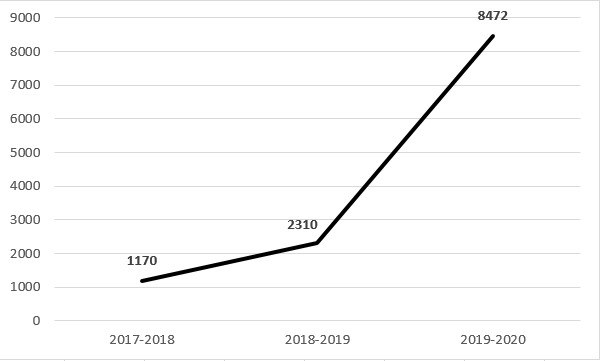
Source: Administrative data, ESDC’s Common System for Grants and Contributions (2021)
Figure 2. Text version
| Time period | Number of work opportunities |
|---|---|
| 2017 and 2018 | 1,170 |
| 2018 and 2019 | 2,310 |
| 2019 and 2020 | 8,472 |
Participation in the program increased exponentially over the first 3 fiscal years of program activities (April 2017 to March 2020). In the first 2 years, the program’s eligibility criteria were exclusive to science, technology, engineering and mathematics and business students. However, in 2019 the program revised its eligibility criteria to include science, technology, engineering and mathematics and the arts as well as all other disciplines.
National distribution of the program’s work placements is reflected in the two figures below. Figure 3 reflects participation during the first two years, while figure 4 reflects participation after the program’s criteria were expanded in 2019. A noticeable increase in participation in Quebec, Northern Canada and in many of the Prairie and Atlantic provinces can be observed.
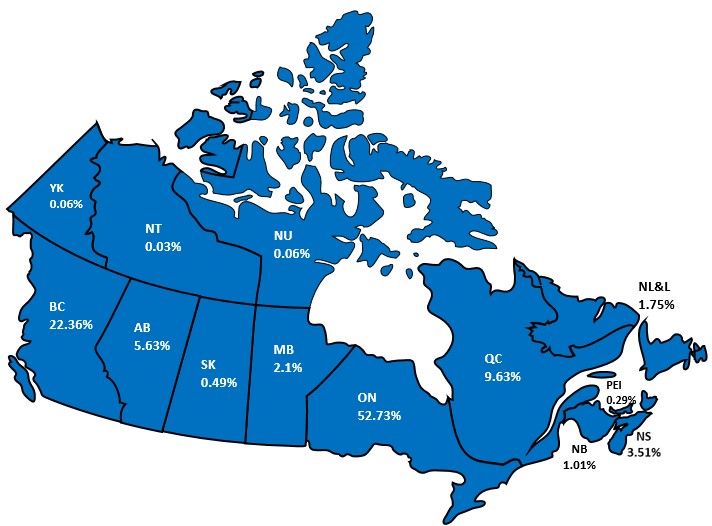
Source: Administrative data, ESDC’s Common System for Grants and Contributions (2021)
Figure 3. Text version
| Provinces and territories | Distribution of work-integrated learning opportunities across Canada from 2017 and 2018 to 2018 and 2019 |
|---|---|
| Alberta | 5.63% |
| British Columbia | 22.36% |
| Manitoba | 2.1% |
| New Brunswick | 1.01% |
| Newfoundland and Labrador | 1.75% |
| Northwest Territories | 0.03% |
| Nova Scotia | 3.51% |
| Nunavut | 0.06% |
| Ontario | 52.73% |
| Prince Edward Island | 0.29% |
| Quebec | 9.63% |
| Saskatchewan | 0.49% |
| Yukon | 0.06% |
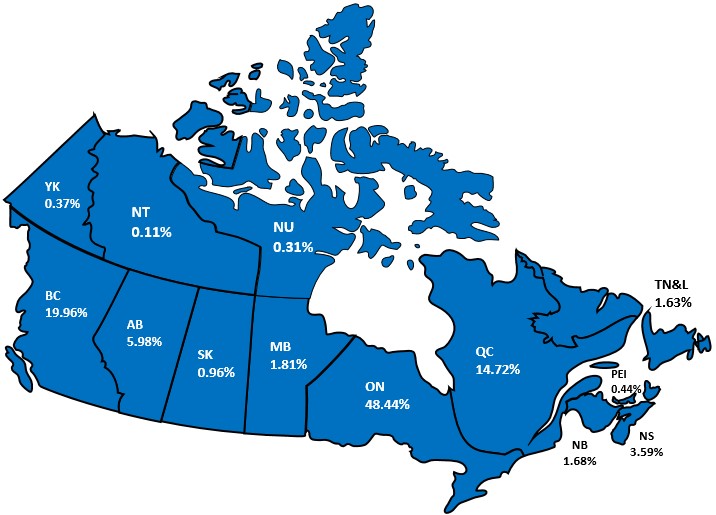
Source: Administrative data, ESDC’s Common System for Grants and Contributions (2021)
Figure 4. Text version
| Provinces and territories | Distribution of work-integrated learning opportunities across Canada from 2019 and 2020 |
|---|---|
| Alberta | 5.98% |
| British Columbia | 19.96% |
| Manitoba | 1.81% |
| New Brunswick | 1.68% |
| Newfoundland and Labrador | 1.63% |
| Northwest Territories | 0.11% |
| Nova Scotia | 3.59% |
| Nunavut | 0.31% |
| Ontario | 48.44% |
| Prince Edward Island | 0.44% |
| Quebec | 14.72% |
| Saskatchewan | 0.96% |
| Yukon | 0.37% |
Key finding #8
The majority of students were enrolled in a university bachelor program, were male and were between the ages of 20 to 24 years old. However, inaccurate and inconsistent data collection and reporting created limitations in the analysis.
The majority (80%) of participating students were enrolled in a university bachelor program followed by 9% enrollment in a college and Cégep diploma program (Figure 5).Footnote 2
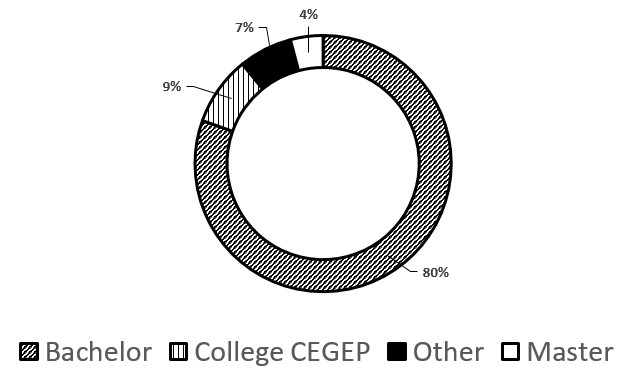
Source: Administrative data, ESDC’s Common System for Grants and Contributions (2021)
Figure 5. Text version
| Post-secondary program | Percentage of students who had work-integrated learning opportunities |
|---|---|
| Bachelor | 80% |
| College CEGEP | 9% |
| Other | 7% |
| Master | 4% |
During the period between 2017 and 2018 to 2019 and 2020, students whose placements were funded by the program were more likely to be male (63%), and between 20 and 24 years old (Figure 6).Footnote 3
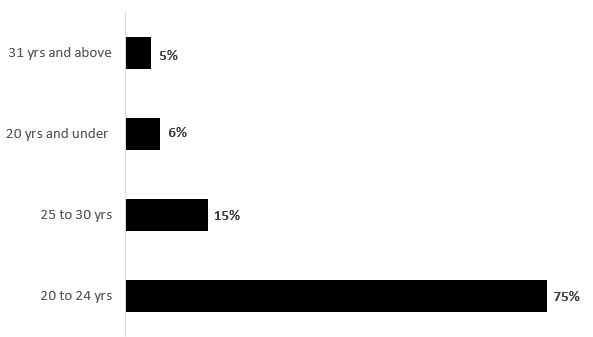
Source: Administrative data, ESDC’s Common System for Grants and Contributions (2021)
Figure 6. Text version
| Age distribution | Percentage of students who worked integrated learning opportunities |
|---|---|
| 20 to 24 years old | 75% |
| 25 to 30 years old | 15% |
| Less than 20 years old | 6% |
| More than 31 years old | 5% |
Key finding #9
Male students had higher participation rates in sectors that are traditionally male dominated, while female students had higher participation rates in bio-technology.
Male students were represented (from 54% to 79%) in sectors that are traditionally male dominated. Such as:
- aviation
- information and technology (including cyber security and artificial intelligence)
- electricity and mining
Meanwhile, the proportion of female students in the bio technology sector was 56% (Figure 7).
According to administrative data, 75% of all participating female students were enrolled in science, technology, engineering and mathematics programs.
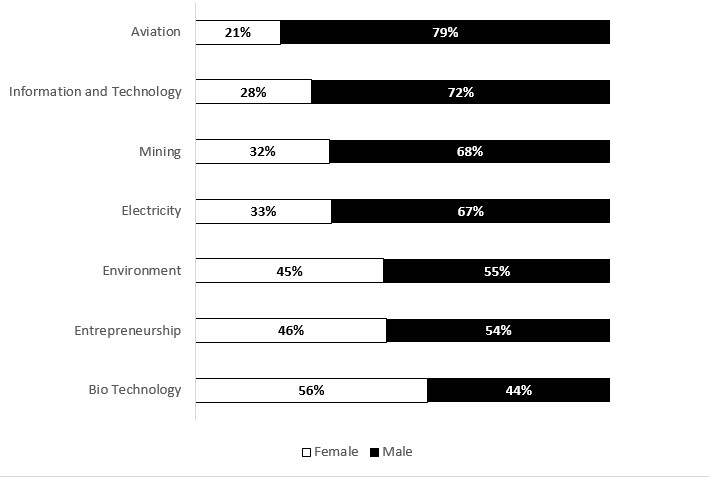
Source: Administrative data, ESDC’s Common System for Grants and Contributions (2021)
Figure 7. Text version
| Students by sector of activity | Female students | Male students |
|---|---|---|
| Bio Technology | 56% | 44% |
| Entrepreneurship | 46% | 54% |
| Environment | 45% | 55% |
| Electricity | 33% | 67% |
| Mining | 32% | 68% |
| Information and Technology | 28% | 72% |
| Aviation | 21% | 79% |
Key finding #10
Thirty-two percent (32%) of all work-integrated learning opportunities were represented by women in science, technology, engineering and mathematics, followed by 18% for first year students.
Document reviews revealed that the program focused on creating work-integrated learning opportunities for students in the following under-represented groups:
- women in science, technology, engineering and mathematics
- Indigenous students
- persons with disabilities
- newcomers
- first year students
The program offered enhanced wage subsidies as an incentive to employers to offer placements for students who had lacked access to work-integrated learning opportunities.
First year students often had difficulty securing work placements because employers preferred to hire students who were further along in their studies. As such, funding recipients were encouraged to create work placements for students in their first year of their post-secondary education.
Document reviews showed that, out of the total of 11,952 work-integrated learning opportunities, 18% represented first-year students.
Women in science, technology, engineering and mathematics accounted for 32% of all the program’s work placements. Where as, newcomers represented 3%, Indigenous students represented 2% and persons with disabilities represented 2% of all the work placements (Figure 8). Notably, some students self-identified with more than one under-represented group.
Additionally, funding recipients representing sectors that are traditionally male dominated were committed to promoting gender diversity as well as creating partnerships with employers in Northern communities. However, some of them reflected that recruiting Indigenous students and students with disabilities was challenging due to their decreased post-secondary enrollment.
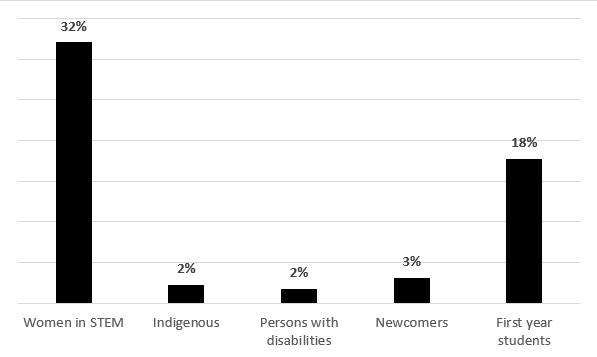
Source: Administrative data, ESDC’s Common System for Grants and Contributions (2021)
Figure 8. Text version
| Under-represented groups | Percentage of students who identify with under represented group |
|---|---|
| Women in STEM | 32% |
| First year students | 18% |
| Newcomers | 3% |
| Indigenous | 2% |
| Persons with disabilities | 2% |
3.4 Benefits for students
Key finding #11
The large majority of students reported that their improvement in work ready skills, including time management, critical-thinking, problem solving and oral communication, was attributed to their participation in the program.
One of the program’s expected outcomes was that post-secondary students would improve their “work-ready” skills upon completion of one of the program’s work placements.
Based on the exit surveys and interviews with students work-integrated learning opportunities were instrumental in improving a broad range of skills and abilities. Due to their participation in the program (Figure 9), the large majority of students indicated an improvement in their work-related skills such as:
- time management (93%)
- critical-thinking (92%)
- problem solving (83%)
- oral communication (87%)
In addition, students particularly valued the improvement to their communication and interpersonal skills. This included both oral and written communication with people outside their immediate team, management and with clients. Work-integrated learning opportunities also improved students’ skills in time management, increased their confidence and helped them learn how to act professionally and work as a team.
Moreover, students were able to expand their knowledge and apply and refine the technical skill they learned in school to their work environments. Examples of technical learning include:
- information and technology
- engineering
- accounting
- marketing
- design
- administration
- auditing
- animation techniques
- quality assurance
- safety protocols
- social marketing
- data collection
- healthcare

Source: ESDC’s Exit survey with students (2020)
Figure 9. Text version
| Work-related skills | Percentage of students who indicated that the program’s work placement improve specific work-related skills |
|---|---|
| Time management | 93% |
| Critical-thinking | 92% |
| Oral communication | 87% |
| Problem solving | 83% |
Key finding #12
The majority of employers indicated that as a result of participating in the program students improved their work-ready skills.
As shown in Figure 10, employers believed that, throughout the program’s work placements, there were either some or significant improvements in students’ abilities and skills. Specifically, working with others (96%), adaptability (94%) and oral communication (94%) were some of the areas where employers noticed some of the most significant improvements.
These results are also consistent with data collected from ESDC’s 2021 student interviews and the 2020 Exit surveys with students.

Source: ESDC’s Exit survey with employers (2020)
Figure 10. Text version
| Employers who indicated that the program improved work related skills and abilities in the following areas | No Opportunity | No Improvement | Minimal Improvement | Some Improvement | Significant Improvement |
|---|---|---|---|---|---|
| Working with others | 2% | 0% | 2% | 27% | 69% |
| Working independently | 7% | 1% | 7% | 36% | 50% |
| Adaptability | 1% | 1% | 4% | 31% | 63% |
| Critical thinking | 2% | 1% | 7% | 40% | 50% |
| Problem solving | 2% | 1% | 5% | 40% | 53% |
| Time management | 20% | 2% | 8% | 36% | 35% |
| Oral communication | 1% | 1% | 3% | 36% | 59% |
Key finding #13
Work-integrated learning opportunities contributed to students improving their employability and being able to make informed decisions about their career choices.
Exit surveys with employers revealed both their most and least valued skills when hiring new employees. Some of these most valued skills are also reflected in students’ self-assessment referenced in Figure 9.
Interviews with both funding recipients and students indicated that work-integrated learning opportunities helped participating students to better understand workplace culture and technologies.
The program’s work placements were an opportunity for students to confirm career choices or discover other potential career paths. Some of the students, who participated in interviews, said their placement confirmed what they already thought they wanted to do after graduating. Some others said the program’s work placement helped them to better understand their career interests.
According to interviews with funding recipients, work-integrated learning opportunities allowed students to discover new sectors of activity (for example: mining, electricity) that they would not have considered prior to the program’s work placement.
The program’s work placements were also an opportunity to experiment with different roles and responsibilities as well as to develop a network. Student interviews reflected that they believed the program’s work placement will look good on their resumes and would help in (or has already helped) finding work in their field.
Information from case studies and interviews with funding partners showed that, in some cases, students continued to work for the same employer on a part-time basis when they returned to school full-time or were hired after graduation.
Employers’ 5 most valued 5 skills and abilities when hiring new employees:
- problem solving (80%)
- motivation to learn (80%)
- working as a team (79%)
- initiative (77%)
- working independently (77%)
Employers’ 5 least valued skills and abilities least important when hiring new employees:
- numeracy (29%)
- imagination and creativity (49%)
- emotional intelligence (51%)
- working under pressure (59%)
- organization (60%)
3.5 Benefits for employer
Key finding #14
More than 3,000 employers received program funding to create work-integrated learning opportunities between 2017 and 2018 to 2019 and 2020.
Funding recipients have significantly increased the number of partnerships with employers. These unique partnerships increased from 517 in 2017 and 2018 to 2,115 in 2019 and 2020 (Figure 11).
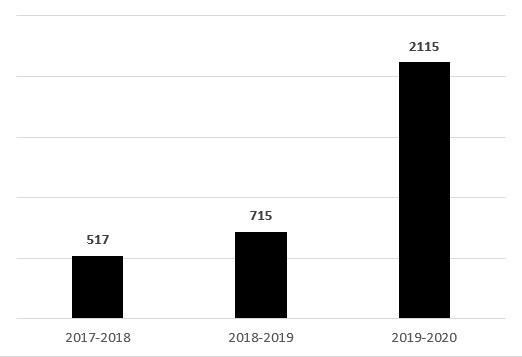
Source: Administrative data, ESDC’s Common System for Grants and Contributions (2021)
Figure 11. Text version
| Year | Number of partnerships with unique employers |
|---|---|
| 2017 and 2018 | 517 |
| 2018 and 2019 | 715 |
| 2019 and 2020 | 2115 |
From the total number of partnerships created with employers, the proportion with small-sized enterprises increased from 74% in 2017 and 2018 to 82% in 2019 and 2020 (Figure 12).
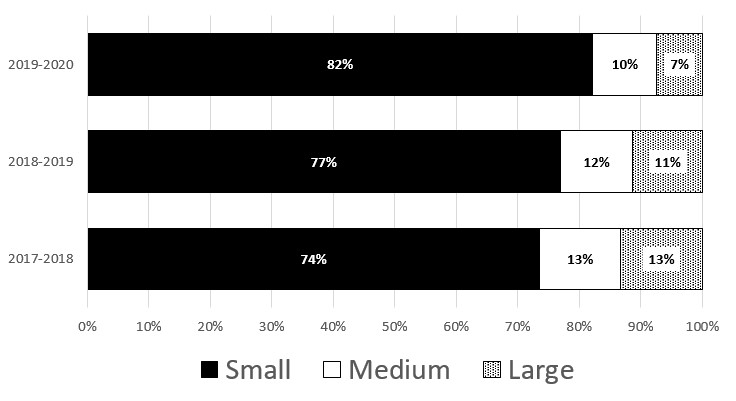
Source: Administrative data, ESDC’s Common System for Grants and Contributions (2021)
Figure 12. Text version
| Distribution of partnerships with employers, based on company size | Small | Medium | Large |
|---|---|---|---|
| 2017 and 2018 | 74% | 13% | 13% |
| 2018 and 2019 | 77% | 12% | 11% |
| 2019 and 2020 | 82% | 10% | 7% |
Key finding #15
Work-integrated learning opportunities had multiple benefits for the majority of employers.
All employers reported some main benefits of work-integrated learning opportunities, including:
- access to creativity, knowledge and skills (72%)
- productivity and service delivery enhancements (60%)
- ability to address short-term workflow pressure (52%)
- opportunity to build stronger connections with education institutions (51%)
99.4% of employers believed the program’s work placements benefited their company
Employers all reported that the program’s work-integrated learning opportunities made important contributions to addressing their company’s needs.
Case studies and interviews with funding recipients showed that the program was very useful for small enterprises. Specifically, it helped build capacity on how to work with post-secondary institutions and how to hire students. For larger enterprises, where hiring students is considered a corporate responsibility, the program increased their talent pool.
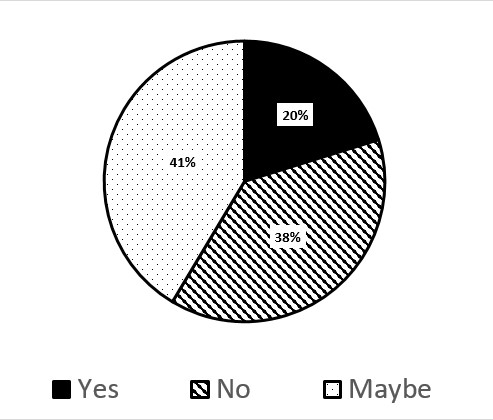
Source: ESDC’s Exit survey with employers (2020)
Figure 13. Text version
| Would you have offered a work placement without the financial incentives offered by the federal government, through the Program? | Percentage |
|---|---|
| Maybe | 41% |
| No | 38% |
| Yes | 20% |
Surveys and interviews with employers showed that the wage subsidy provided by the programFootnote 6 is beneficial for creating work placements.
Among surveyed employers, 20% said they would have offered a work placement without the wage subsidy and 41% said they may have offered one.
However, for 38% this would have not been possible without the financial support of the program (Figure 13).
Key finding #16
Sixty-eight percent (68%) of employers would consider using work placements in the future. However, the onboarding and supervision of new students as well as the additional administration were perceived as an added burden.
The majority (68%) of employers surveyed said they would consider using work placements to support human resources planning in the future, compared to 8% of employers who do not intend to use them.
In addition to financial reasons, results from the survey with employers identified a few other challenges to offering a work placement (Figure 14). Those reasons included:
- extra work generated by onboarding and supervising new students
- administrative burden
- time required to hire students
- lack of candidates who meet the skills needs of the organization
More than 34% of employers said their experience with the program increased their overall interest in using work placements. Most of these participants also said that the removal of the wage subsidies would be problematic.
Several employers, who were interviewed, said that even without the program’s wage subsidies they would have continued to hire students at a similar rate. However, the majority of these employers said that, without the program’s funding, they would have hired fewer students.
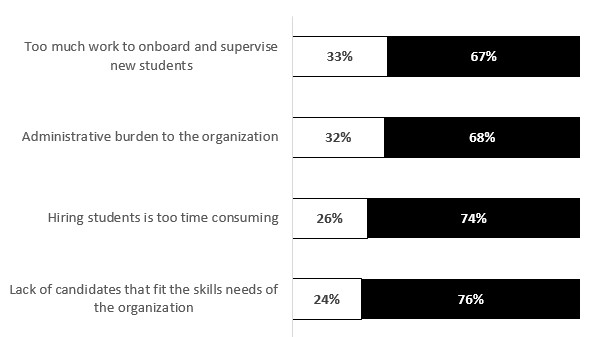
Source: ESDC’s Exit survey with employers (2020)
Figure 14. Text version
| What are non-financial challenges to offering work placements? | Percentage |
|---|---|
| Too much work to onboard and supervise new students | 33% |
| Administrative burden to the organization | 32% |
| Hiring students is too time consuming | 26% |
| Lack of candidates that fit the skills needs of the organization | 24% |
3.6 Satisfaction with the program
Key finding #17
The large majority (95%) of students and employers were satisfied or very satisfied with the program’s work placements.
Nine out of ten participating students believed their work placement related to their post-secondary studies.Footnote 7
Almost all surveyed students (95%) were either satisfied or very satisfied with the program’s work placements (Figure 15). For many of them, it was an opportunity to learn and qualified as “excellent”, “rewarding” and “stimulating”.
Interviews and survey results with students showed that one of the main reasons they rated their program work placements so high was due to the support they received from employers. For example:
- students benefited from a variety of supports including training, mentorship and guidance, regular meetings and check-ups and general support from their team
- almost all employers (95%) were either satisfied or very satisfied with the students’ performance during their work placements (Figure 16)
- employers identified students’ knowledge, a broad range of skills and competencies, their added-value and meeting job expectations as the main reasons for their satisfaction with students’ performance
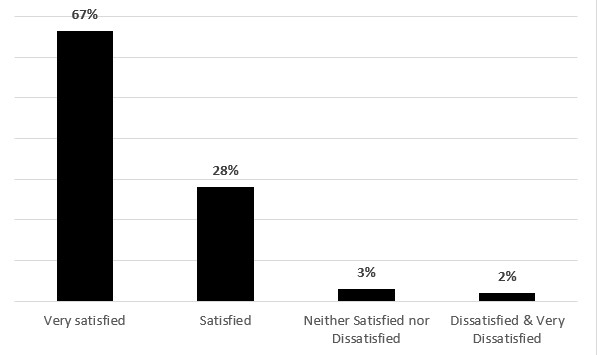
Source: ESDC’s Exit survey with students (2020)
Figure 15. Text version
| Student level of satisfaction with program’s work placement | Percentage |
|---|---|
| Very satisfied | 67% |
| Satisfied | 28% |
| Neither satisfied nor dissatisfied | 3% |
| Dissatisfied and very dissatisfied | 2% |
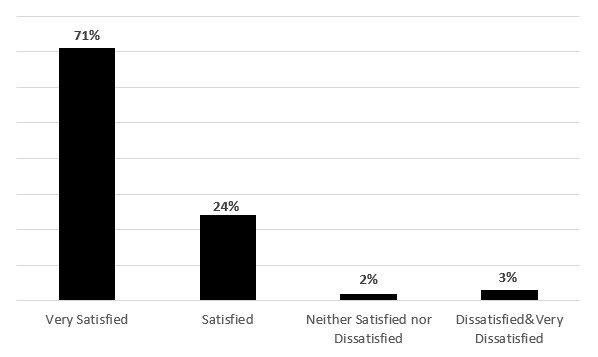
Source: ESDC’s Exit survey with employers (2021)
Figure 16. Text version
| Student level of satisfaction with program’s work placement | Percentage |
|---|---|
| Very satisfied | 71% |
| Satisfied | 24% |
| Dissatisfied and very dissatisfied | 3% |
| Neither satisfied nor dissatisfied | 2% |
Key finding #18
The majority of employers were satisfied or very satisfied with the support received from funding recipients. However, participants from post-secondary institutions expressed mixed opinions on their relationship with funding recipients.
Surveyed employers were either satisfied (36%) or very satisfied (39%) with the level of overall support provided by funding recipients. Only 6% of them were dissatisfied and 4% very dissatisfied with the support received.
Interviews with employers showed widespread praise for funding recipients’ strong communication and response to questions. A few employers believed response times were slow.
Participants from the post-secondary institutions’ survey expressed mixed-opinions on their relationship with funding recipients. For example:
- those who had Memoranda of Understanding with funding recipients perceived the relationships positively as it leveraged strong collaboration and easy access to information
- when Memoranda of Understanding were not in place, post-secondary institutions did not believe they were involved in the decision-making process and were not always aware of when students and employers received funding from the program
- 87% of employers who participated in interviews and surveys expressed high levels of satisfaction with the overall application process and administration (Figure 17)
- Employers also believed the application process was essentially clear and straightforward. If they had questions or needed support, the funding recipients addressed these needs
- Several of the participants working with Magnet believed the application process was more difficult and lengthier to complete
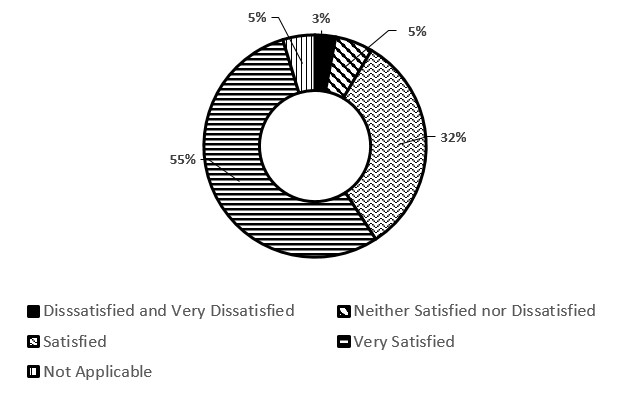
Source: ESDC’s Exit survey with employers (2021)
Figure 17. Text version
| Employer satisfaction with application process and level of administration burden | Percentage |
|---|---|
| Very Satisfied | 55% |
| Satisfied | 32% |
| Neither Satisfied nor Dissatisfied | 5% |
| Not Applicable | 5% |
| Dissatisfied and Very Dissatisfied | 3% |
Key finding #19
Stakeholders were satisfied with the program’s design and delivery features regarding wages, subsidies and the COVID-19 temporary measures. They also identified multi-year agreements as a strength that facilitated ongoing relationships and long-term planning
Interviews with students and employers reported that they were satisfied with the amount of either their wages or wage-subsidies. For employers, this included both the pre-COVID subsidies as well as the increased subsidies in response to COVID-19. Students also stated that their wages were sufficient to cover their cost of living.
According to employer interviews, wage subsidies allowed employers to hire students they otherwise could not have afforded to hire and also allowed them to offer more competitive wages. This helped attract students to apply for and accept program work placements. Exit surveys with employers revealed that 81% were satisfied with the level of program funding. Although, 4.5% stated that they were either dissatisfied or very dissatisfied.
According to interviews with funding recipients, many of them stated that multi-year contribution agreements are one of the main strengths of the program. They indicated that these types of agreements facilitate ongoing relationships between employers and post-secondary institutions and allow for longer-term planning.
Specifically, without the multi-year agreements in place, employers were pressured to complete the program’s work placements by March 31st. However, this is prior to the end of the post-secondary winter semesters. As such, the duration of placements was potentially impacted. Multi-year contribution agreements helped to reduce this challenge.
Employers, funding recipients and stakeholders from post-secondary institutions reported high satisfaction with the changes implemented by the program as part of the COVID-19 temporary measures.
The COVID-19 pandemic had a negative impact on creating new work-integrated learning opportunities and continuing the ones that were already in place. For example:
- feedback from funding recipients and post-secondary institutions resulted in the program being able to make quick changes to the program in response to COVID-19 related challenges. The first set of measures, including increased wage subsidy to 75% for all of the program’s work placements was announced in April 2020, shortly after the start of the pandemic
- temporary COVID-19 measures allowed employers to continue creating program work placements and allowed students to continue gaining relevant work experience. Virtual work-integrated learning opportunities led to increased accessibility to the program for employers and students in remote regions
The employer eligibility expansion to include post-secondary institutions compensated for some of the smaller enterprises’ inability to hire students during this period.
Key finding #20
The “net new” requirement and the ineligibility of international students were considered to be program design limitations.
Employers had to demonstrate that each program work placement was “net new”. This meant that employers were required to ensure that all new work-integrated learning opportunities were additional to the number of work placements the employer offered in the year prior to receiving program funding. This ensured that new funding was not allocated to students hired outside of the program. For instance:
- several funding recipients mentioned in their interviews that, for very large enterprises it is difficult to have an accurate tally of the students hired the year before. Meanwhile, small enterprises’ challenge was that their capacity to hire students varies from one year to the next
- there is also some confusion regarding the understanding of the “net new” requirement. Several employers understood it to be an inability to hire the same student for a second work term
- several stakeholders reflected that the removal of the “net new”, as a result of the COVID-19 temporary measures, was a positive change. They suggested that it become a permanent design feature
The ineligibility of international students was perceived to be a program design limitation by several employers and funding recipients as well as almost half of the survey participants from post-secondary institutions.Footnote 8 Some of the explanations included:
- the ineligibility of international students is a missed opportunity for supporting the future integration of international students into the Canadian workforce. Some participants mentioned that, in the Atlantic region, international students are part of their workforce strategy
In some fields of study, there is a strong presence of international students. For example, between 2010 and 2011 to 2018 and 2019, enrollments of international students in Canadian science, technology, engineering and mathematics programs more than doubled from 12% in 2010 and 2011 to 29% in 2018 and 2019.Footnote 9
There is an increasing trend of international students becoming permanent residents in Canada. In April 2021, the Government of Canada announced a new pathway to permanent residency for 40,000 recent international student graduates.
A recent study showed that the “pre-graduation work experience” accounted for most of the earnings discrepancy for international graduates compared to those of domestic students in the first five years following graduation.Footnote 10
3.7 Transition to the workforce
Key finding #21
As a result of participating in the program, the majority of employers would consider using work placements in the future as well as hiring some of the program’s placement students on a long-term basis. However, 20% were either undecided or would not hire students on a long-term basis.
The evaluation did not focus on measuring the longer term impact of the program. However, several lines of evidence showed that the program has been successful in supporting students’ transition from post-secondary education to the workforce.
As shown in Figure 18, the majority of employers surveyed would consider hiring students long term (73%). Only 5% indicated that they would not.
Almost all employers who were interviewed stated they would be interested in hiring some of program’s work placement students. Some had already done so.
The program’s work placements allowed employers to identify students who were a good fit for their company in terms of technical and soft skills, according to employer interviews.
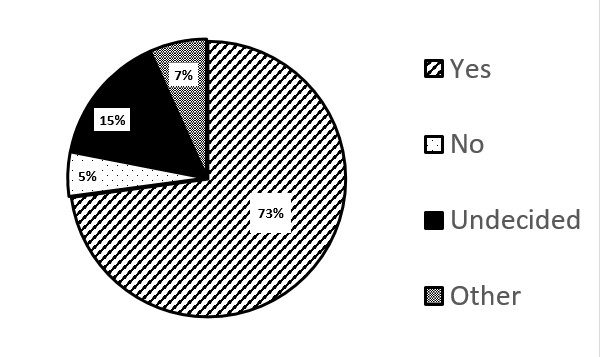
Source: ESDC’s Exit survey with employers (2020)
Figure 18. Text version
| Would you consider hiring this student long term? | Percentage |
|---|---|
| Yes | 73% |
| Undecided | 15% |
| Other | 7% |
| No | 5% |
Thirty-six percent (36%) of the students who were interviewed had been offered a job in their field, and most of them had accepted the offer.
Evidence from case studies also revealed that some of these students will retain their employment on a part-time basis once they return to school. In several cases, employers indicated that they hoped to hire these students full-time when they have completed their studies.
4. Conclusion
The Student Work Placement Program addresses the needs of participating employers and students by filling a program gap and supporting a better alignment between skills learned at post-secondary institutions and the evolving needs of industry across Canada.
This third party delivery model supported the creation of work-integrated learning opportunities for post-secondary students. It also created multi-stakeholder partnerships between small and medium-sized enterprises and post- secondary institutions as well as offered training for students on work-ready skills.
The majority of funding recipients:
- executed outreach and communication campaigns
- created national steering committees
- offered dedicated webpages
- developed training opportunities for participants
The program’s unique design and delivery features supported an eight-fold increase in work-integrated learning opportunities over the evaluation period (from 2017 to 2020). In fact, the program also saw increases in participation in Quebec, Northern Canada and most of the Prairie and Atlantic provinces. Partnerships between industry and post-secondary institutions also quadrupled during that same timeframe.
The majority of students and employers (95%) were satisfied or very satisfied with the program’s work placements. Employers were equally satisfied with the design and delivery of the program as well. This included satisfaction with the program’s wages or wage subsidy amounts both prior to and during the COVID-19 pandemic. Multi-year agreements, which facilitated partnerships and long-term planning, were also seen as a strength by employers and post-secondary institutions.
Work-integrated learning opportunities helped the large majority of students improve their work ready skills. Employers’ assessment of students validated students’ self-assessments with regard to improvements in critical-thinking, oral communication, problem solving and time management.
Work placements also helped them learn how to act professionally, work as a team, understand early work-related expectations, decide on a career path and make linkages between theory and practice.
Moreover, employers reported that the program benefited their companies and made important contributions to addressing their needs. They were also satisfied with the support they received from the funding recipients as well as with the application process and administration involved in hosting the work placements.
Additionally the majority of employers (73%) reported that they would consider hiring some of the students on a long-term basis. In fact, 36% of the students who had been interviewed had already been offered a job in their field.
Overall, stakeholders were satisfied with the program, however, it faced a few challenges. These challenges include:
- a lack of awareness and understanding of the program by students and employers
- inaccessible and inconsistent training for all eligible students
- program information not being available in both official languages
- inconsistencies and inaccuracies of data collection and reporting which limited in depth analysis of the specific elements of the program
Consistent feedback from funding recipients and employers supported the request to both remove the “net new” requirement permanently from the program.
5. Management response action plan
Overall Management response
The Student Work Placement Program supports partnerships between industry and post-secondary institutions, to create quality work-integrated learning (WIL) opportunities for post-secondary students. Work-integrated learning helps students gain relevant, real-life work experiences and the skills required by employers to secure meaningful employment upon graduation.
Findings from the Evaluation indicate there is an ongoing need for the Program to support better alignment between the skills of post-secondary students and the evolving needs of employers in Canada. The Program is addressing gaps left by other federally funded programs through its unique design and delivery, which includes a focus on creating multi-stakeholder partnerships, and unrestricted participant age, enrollment status and field of study.
Overall students and employers are highly satisfied with their work placements. Students are improving their work - ready skills, employability and their ability to make informed decisions about their career, while employers are experiencing multiple benefits to their company, including accessing creativity, knowledge and skills.
Recommendation #1
Improve program awareness and understanding, amongst students, employers and post-secondary institutions across Canada.
Management response
Management agrees with the recommendations to improve program awareness and understanding among students, employers and post-secondary institutions. As such, the Department will engage funding recipients to ensure clarify of expectations with respect to activities related to promote and expand the reach of the program. The Department will also facilitate knowledge exchange amongst funding recipients on what works and does not work to raise awareness of programming, including improving understanding of the benefits of work-integrating learning placements for all involved.
Given the Program is committed to promoting diversity and inclusion and increasing awareness amongst under-represented students, focus will be placed on engaging stakeholders to identify ways to improve outreach and participation. The Department will engage organizations that work with under-represented groups to strengthen understanding of effective practices and encourage collaboration amongst organizations to expand reach to target audiences.
ESDC will also promote the Student Work Placement Program directly to youth through the Youth Digital Gateway. This six- year initiative (2019 to 2025) established a Government of Canada digital platform that offers a single point of access to information on federal programming for youth. Through the Youth Digital Gateway, youth will be able to search opportunities supported by the Student Work Placement Program.
Management action plan
- 1.1 Strengthen communications with funding recipients on program expectations related to activities to promote and expand the reach of the program
- Completion date: Winter 2022
- Lead: Program Operations Branch
- 1.2 Develop and implement a stakeholder engagement plan, including organizations that support students from diverse groups
- Completion date: Spring 2022
- Lead: Skills and Employment Branch
- 1.3 Make information on opportunities funded by the Student Work Placement Program available through the Youth Digital Gateway
- Completion date: Fall 2022
- Lead: Transformation Management Branch, supported by Skills and Employment Branch and Program Operations Branch
Recommendation #2
Encourage the development of “work-ready” training opportunities, which are available to participants, as a complement to their work placement experience.
Management response
The Department will undertake further research and analysis, including stakeholder engagement, to better understand “work-ready” training opportunities that complement student work placements. As the Program supports students currently enrolled in post-secondary education, consideration will be given to identify gaps in skills development opportunities between the classroom and work placements.
Management action plan
- 2.1 Develop and implement stakeholder engagement plan as well as conduct further research and analysis
- Completion date: Spring 2022
- Lead: Skills and Employment Branch
Recommendation #3
Increase program accessibility by continuing to address official language gaps related to communication and documentation.
Management response
Management agrees wit the recommendation to increase program accessibility by continuing to address official language gaps related to communication and documentation. Through contributions agreements, the Department seeks commitments from program funding recipients with respect to both official languages when making any announcement, project-related service offerings, documentation and information for general public use, and accommodating specific needs, as appropriate including those of official language minority communities. The Department will strengthen communications with funding recipients regarding expectations around official languages and will monitor projects more closely to address gaps proactively.
Management action plan
- 3.1 Strengthen communications with funding recipients on program expectations related to official languages
- Completion date: Winter 2022
- Lead: Program Operations Branch
- 3.2 Enhance Operational Guidelines for Project Officers to reinforce official language requirements and strengthen departmental capacity to effectively communicate expectations with funding recipients, monitor projects and address gaps
- Completion date: Spring 2022
- Lead: Program Operations Branch
Recommendation #4
Consider addressing the suggestions from employers and funding recipients to permanently remove the “net new” requirement for employers.
Management response
Management agrees with recommendation to consider permanently removing the “net new” requirement for employers who participate in the Program. The net new rule states that employers are only provided funding for the number of new placements they create beyond those that they offered in the year prior to receiving program funding. The Program has tested the removal of the net new requirement when it temporarily waived due to the pandemic. This measure resulted in the retention and addition of employers who had to adjust hiring practices because of COVID-19.
The Department will explore the feasibility of sustaining this while examining how to mitigate the risk of creating dependency on federal funding for employers hiring post-secondary students.
Management action plan
- 4.1 Examine feasibility of removing the net new criteria
- Completion date: Fall 2022
- Lead: Skills and Employment Branch, supported by Program Operations Branch
Recommendation #5
Ensure accurate and comprehensive collection, entry and reporting of data providing operational definitions of program variables (for example: age, sex, gender, program and field of study, duration of placement and earnings) as well as technical support including standardized procedure.
Management response
Management agrees with the recommendation to provide operational definitions of program variables, as well as technical support including standardized procedures in order to ensure accurate and comprehensive collection, entry and reporting of data. This would help to provide greater clarity regarding reporting expectations in funding agreements.
Since the end of the evaluation period, the Program has started the process of reviewing and streaming the variables collected, and will be adding operational definitions to each. The Program will incorporate changes into the reporting template, which will result in more accurate and comprehensive data collection and is the foundation for improved analysis and results reporting. Guidance will be provided to aid program funding recipients.
Management action plan
- 5.1 Improve operational definitions and data collection strategy
- Completion date: Fall 2022
- Lead: Skills and Employment Branch, supported Program Operations Branch
- 5.2 Enhance guidance to funding recipients
- Completion date: Winter 2022
- Lead: Program Operations Branch lead, supported by Skills and Employment Branch
Annex A: Student Work Placement Program – Logic Model
Inputs:
Full-time equivalents and funding through the Consolidated Revenue Fund
- Activities:
- 1.1 ESDC will sign and implement agreements with delivery partners; provide ongoing program management; compile, analyze and share relevant and current information on work-integrated learning; and liaise with other departments and levels of government
- 1.2 Delivery partners will i) develop partnerships between employers and post secondary education institutions that work collaboratively to create work-integrated learning opportunities to better align the skills training at post-secondary education institutions with the skills needs of employers in key and emerging sectors of the Canadian economy; provide wage subsidies to employers who create incremental work-integrated learning opportunities, and report and track placement
- Outputs:
- 2.1 Contribution Agreements are established between ESDC and delivery partners; demonstrated by the number of contribution agreements established with delivery partners.
- 2.2 Delivery partners engage and support employers and post-secondary education institutions to create work-integrated learning opportunities; demonstrated by the i) number of employers and post-secondary education institutions participating in student work placements, and ii) number of partnerships between employers and post-secondary education institutions.
- 2.3 post-secondary education students participate in work-integrated learning opportunities; demonstrated by the number of work-integrated learning opportunities for post-secondary education students
- Immediate outcomes:
- 3.1 participating employers recognize that work-integrated learning benefits their company; demonstrated by the percentage of employers who report benefits to their company by providing a work-integrated learning opportunity
- 3.2 participating post-secondary education institutions’ students improve work-ready skills; demonstrated by the percentage of students reporting improved skills upon completion of a work-integrated learning opportunity
- Intermediate outcomes:
- 4.1 participating employers gain access to new talent; demonstrated by the percentage of employers who report using work-integrated learning as a way to support their hiring practices
- 4.2 participating post-secondary education students improve their employability; demonstrated by the percentage of student who report feeling better prepared to enter the labour market upon completion of a work-integrated learning opportunity
- Ultimate outcome:
- 5.1 helping participating students transition from postsecondary education to employment with the work-ready skills sought by employers; demonstrated by the percentage of students employed within 6 months to a year of graduation in their area of expertise.
Annex B: Evaluation questions
The 4 evaluation questions for this phase (Phase I) of the evaluation are as follows:
- To what extent are the objectives and design of the program meeting the needs of employers, post-secondary education institutions and students?
- To what extent are key stakeholders including program staff, funding recipients, employers, post-secondary institutions and students satisfied with the design and delivery of the program?
- To what extent is the program delivery model, which uses funding recipients, effective?
- To what is the program likely to help participating students transition from post-secondary education to employment with the work-ready skills sought by employers?
Annex C: Methodology
The evaluation of the Student Work Placement Program used a mixed-method approach that includes several lines of evidence. This approach ensured adequate data triangulation support robust evidence-based findings, conclusions and recommendations.
Lines of evidence
Scale used to report the findings
“Large majority or most” – findings reflect the views and opinions of at least 75% but less than 90% of key informants in the group.
“Majority” - findings reflect the views and opinions of at least 51% but less than 75% of key informants in the group.
“Some” - findings reflect the views and opinions of at least 25% but less than 50% of key informants in the group.
“A few” - findings reflect the views and opinions of at least two respondents but less than 25% of key informants in the group.
“One” – findings of one highly knowledgeable key informant
Document and literature review
The document and literature review included:
- program documents (program policies, guidelines, contribution agreements)
- departmental reports, federal budget, mandate letters
- recent studies and reports on work-integrated learning in the context of post-secondary education, as well as emerging employer and student needs
- a comparative review of 14 other federal work placement programs identified areas of overlapping and complementarity with the program.
Key limitations
The comparative analysis involved a review of the information provided on the other programs’ websites. As such, insights to elements related to the program were significantly higher than insights related to the other programs.
Administrative data review and analysis
The evaluation team reviewed and analyzed administrative data from the Common System for Grants and Contributions. Data for the period between 2017 and 2012 to 2019 and 2020 was provided by funding recipients as part of quarterly progress reports. Progress reports included information on work-integrated learning opportunities, partnerships with employers and post-secondary education institutions.
Data review included an assessment of the overall quality and accuracy of program administrative data.
Key limitations
Inconsistent reporting by funding recipients limited the accessibility to and reliability of some of the data reported in the progress reports. This included inconsistent reporting of variables such as:
- students’ age
- duration of their work placement, and their program and field of study and in some cases, progress reports included duplicates of:
- work placements
- reporting of sex
- inaccurate information (for example: student reported as both woman in science, technology, engineering and mathematics and as a male)
This evaluation team removed those cases as much as possible.
In some other cases, information was missing on:
- work-integrated learning opportunities, and employers or partnership with post-secondary institutions
The evaluation could not always determine the reasons for the missing information. Additionally in the early stages, most of the funding recipients were reporting every interaction with employers and post-secondary institutions as a new partnership.
One of the objectives of the evaluation was to assess early results of the COVID-19 temporary measures. However, the administrative data for the specific time period was not available for analysis.
Therefore, the evaluation could not thoroughly determine the extent to which some of descriptive results presented in this report are accurate. However, it was estimated that they support a valid enough portrait of the program’s achievements during the evaluation period.
Key information interviews
A total of 65 semi-structured interviews were conducted by telephone or online video, with a diversity of key stakeholders:
- ESDC program officials from the Skills and Employment Branch and the Program Operations Branch, including directors managers and analyst (n=6)
- representatives of funding recipients (n=9)
- employers who received wage-subsidies to create program work placements (n=27)
- students who had work placements supported by the program (n=23)
- the evaluation used a stratified random sample for interviews with employers and students. The sampling frame was composed of:
- employers who offered program work placements to students enrolled in post-secondary programs between April 2019 and August 2020
- students who received program funding between April 2019 and September 2020
Employers and students were stratified by funding recipients and then a random selection of the final sample was created.
Among interviewed employers, about 63% were from enterprises, 25% represented medium enterprises and about 12% were from large enterprises.
Key limitations
Interviews with stakeholders from funding recipients included only those who received ongoing funded during the evaluation period. This included:
- Bio Talent Canada
- Canadian Council for Aviation and Aerospace
- Environmental Careers Organizations of Canada
- Information and Communications Technology Council
- TechNation Canada
- Magnet
- Mining Industry Human Resources Council
- Toronto Finance International
- Venture for Canada
ESDC does not have access to contact information of employers and students. The evaluation reached out to funding recipients to obtain information. Information from one the funding recipients was not available while contact information obtained from other organizations was not always complete nor consistent.
The final composition of interviewed students and employers does not entirely reflect the initial sample structure due to low response rates.
Due to the small number of interviews with employers and students, their views cannot be generalized to full population they represent.
Despite these limitations, key findings from interviews with various types of stakeholders are consistent with those drawn from other lines of evidence. Therefore, they are valid enough to contribute to program decision making in the future.
Case studies
The evaluation carried out 8 case studies of third-party delivery organizations to examine specific features of the funded projects design and delivery (for example: application process, outreach, and training).
Case studies used a mixed-method approach that included:
- a document review of the organizations’ quarterly activity reports available on the Common System for Grants and Contributions for the period between 2017 and 2018 to August 2020
- a review of the organizations’ websites dedicated to projects funded through the program
- interviews with key stakeholders
Key limitations
In some cases, inconsistent and incomplete information available in the organizations’ quarterly reports and on their websites limited the key findings on some aspects of the projects’ design and delivery.
Nevertheless, the mixed-method approach allowed for mitigating many of the limitations. It provided useful insights on how each of the funding recipients took ownership of and implemented their funded projects.
Online survey with post-secondary education institutions
The evaluation conducted a survey with stakeholders from post-secondary institutions to gain insight on aspects such as the level of satisfaction with the program’s design and delivery features, as well as views on the extent to which the program led to concrete results.
The Interactive Fact Funding Service at Employment and Social Development Canada conducted the survey between January 12 and February 5, 2021. The questionnaire consisted of both open-ended and Linkert scale questions.
Key limitations
ESDC does not have direct access to personal contact information for post-secondary institutions. Funding recipients reached out directly to their contacts to invite them to participate in the survey.
Despite intensive recruitment efforts, only 35 participants representing 25 post-secondary institutions participated in the survey.
Their geographical distribution was similar to student placements. However, participants in the Atlantic region were overrepresented. Notably, no institution in Quebec answered the survey.
These limitations were partially mitigated by the fact that students from the 25 post-secondary institutions had about 56% of the total number of work placements funded by the program between 2017 and 2018 to 2019 and 2020.
Exit surveys students and employers conducted by the program
The program designed exit surveys for students and employers. The funding recipients conducted the surveys. The questionnaires includes open-ended and Linkert scale questions. The main purpose of the surveys was to obtain feedback from students and employers on the achievement of program outcomes related to acquiring work-ready skills, increases in student employability, benefits for employers and overall satisfaction with the program’s work placement experience.
The exit surveys for students were distributed during the fall of 2020 by their work placement employer. As such, its data reflects participants’ feedback from both within the evaluation period (April 2017 to March 2020) as well as post evaluation period (fall 2020).
The evaluation team performed a descriptive analysis of qualitative results. In addition, the evaluation team pulled out a stratified random sample of qualitative data. To conduct relevant analysis, the evaluation team used MAXQDA.
Key limitations
The dataset for students included information from 4,106 students. These program work placements were supported by only 6 of the funding recipients who delivered the program during the evaluation period.
The dataset for employers included 3,322 cases among which about 1,700 were unique employers. This is due to the fact that, in some cases, employers filled the survey for more than one student. Additionally, employers indicated that they worked with only 6 of the funding recipients during the evaluation period.
Nevertheless, results were consistent from one funding recipient to another. They were a rich source of information for key findings related to the program’s outcomes and level of satisfaction with program.
Annex D: Comparison analysis summary
To what extent are the objectives and design of the Student Work Placement Program meeting the needs of employers, post-secondary education institutions and students?
- comparison of program against similar programs based on key characteristics and strengths and challenges (Canadian, federal, ongoing, ESDC and non-ESDC, work placement component)
- extent to which, and how, the program complements or fills a gap left by similar programs
Synthesis analysis:
This comparative analysis comprised of 14 federal or federally funded work placement programs in addition to Student Work Placement Program. The following comparison criteria were used:
- objectives
- target population
- geographical representation
- grants and contribution and other sources of funding
- funding amounts
- delivery model and eligible participants
- special features
Of the seven analysis criteria, all except geographical representation and sources of funding demonstrated the program as having either complementary programming or filling a gap left by other similar programs. For example, the unification of unrestricted participant age, enrollment status (both full and part-time) and field of study support both complementary programming as well as fill a program gap.
More notably, the objectives and the special features of the program also demonstrate filling a program gap and a complementary component. The program’s objectives, specifically the focus on creating collaborative multi-stakeholder partnerships between industry and post-secondary institutions across Canada, is unique and not highlighted by other similar programs.
Moreover, when comparing special features, The Student Work Placement Program’s focus on the training of essential and non-technical skills to complement post-secondary institutions’ technical skills training is an enhancement to the scope of work placement programs across Canada.
Limitation: This comparative analysis involved a review of the information provided on the other programs’ websites. As such, insights to program elements related to Student Work Placement Program were significantly higher than insights related to the other programs. A comprehensive review of the other programs, beyond the information contained on their websites would be required to gain a fulsome understanding of their challenges. As such, this component of the analysis is not captured in this analysis.
Comparable programs
The Student Work Placement Program was compared with 14 other federal work placement programs and one non-government, federally funded, work placement program or equivalent (for example: coop, internship):
- Canada Summer Jobs federally managed by Employment and Social Development Canada
- Youth Employment Skills Strategy (YESS) federally managed by Employment and Social Development Canada
- Digital Skills for Youth Program (part of YESS) federally managed by Innovation, Science and Economic Development Canada
- Computers for Schools Internship Program (part of YESS) federally managed by Innovation, Science and Economic Development Canada
- Science and Technology Internship Program - Green Jobs (part of YESS) federally managed by Natural Resources Canada
- Science Horizons Youth Internship Program (part of YESS) federally managed by Environment and Climate Change Canada
- Industrial Research Assistance Program Youth Employment Program (part of YESS) federally managed by National Research Council of Canada
- First Nations and Inuit Summer Work Experience Program (part of YESS) federally managed by Indigenous Services Canada
- First Nations and Inuit Skills Link Program (part of YESS) federally managed by Indigenous Services Canada
- Federal Student Work Experience Program federally managed by Public Service Commission
- Post-Secondary Co-op and Internship Program federally managed by Public Service Commission
- Research Affiliate Program federally managed by Public Service Commission
- Young Canada Works federally managed by Canadian Heritage
- Mitacs federally managed by Innovation, Science and Economic Development Canada
Bibliography
Abacus Data. (2016). Work Integrated Learning and Post-Secondary Education: What Students Think. A study of the perceptions and attitude of students about work-integrated learning. Available at: https://www.bher.ca/sites/default/files/documents/2020-08/What-students-think.pdf
Burt, M. and Crawford, T. (2020). Technological Change and the Future of Work in Canada. Future Skills Centre. Accessible at: Technological Change and the Future of Work in Canada | Future Skills Centre • Centre des Compétences futures (fsc-ccf.ca)
Business Council of Canada. (2018). Navigating Change: 2018 Business Council Skills Survey. Morneau Shepell. Available at: Navigating Change - 2018 Business Council Skills Survey
Business Council of Canada. (2020). Investing in a resilient Canadian workforce: 2020 Business Council of Canada Skills Survey. Morneau Shepell. Available at : https://thebusinesscouncil.ca/app/uploads/2020/08/2020-BCC-Skills-Survey-Report_Final.pdf
Business/Higher Education Roundtable. (2018). Submission: HUMA study on Experiential Learning and Pathways to Employment for Canadian Youth. Available at: BHER HUMA June 1 2018.pdf
Business/Higher Education Roundtable. (2018). Pre-budget consultations in advance of Budget 2019. Available at: BHER Pre-Budget 2019 submission
Canadian Federation of Independent Business. (2018). Hire Education: Connecting Youth and Small businesses for the jobs of today. Youth Employment Report (cfib-fcei.ca)
ESDC’s Case Studies (2021). Internal, unpublished draft document (available on demand)
ESDC’s Comparative Analysis (2021). Internal unpublished draft document (available on demand)
ESDC. (2016). Understanding the Realities: Interim report of the Expert Panel on Youth Employment, 2016. Government of Canada. Accessible at: Understanding the Realities: Interim report of the Expert Panel on Youth Employment, 2016 - Canada.ca
Government of Canada (2021). New pathway to permanent residency for over 90,000 essential temporary workers and international graduates, https://www.canada.ca/en/immigration-refugees-citizenship/news/2021/04/new-pathway-to-permanent-residency-for-over-90000-essential-temporary-workers-and-international-graduates.html.
House of Commons. Standing Committee on Human Resources, Skills and Social Development and the Status of Persons with Disabilities. (2018). Experiential Learning Pathways to Employment for Canadian Youth, October 2018, 42nd Parliament, 1st Session. Accessible at: Experiential Learning and Pathways to Employment for Canadian Youth
Lenarcic Bliss, D. and Pichette, J. 2018. Minding the gap? Ontario Postsecondary Students’ Perceptions on the State of their Skills. Higher Education Quality Council of Ontario. Available at: https://heqco.ca/wp-content/uploads/2020/02/Formatted_-Student-Skills-Survey_FINAL.pdf
McRae, N., Pretti, T. J., and Church, D. (2018). Work-Integrated Learning Quality Framework. University of Waterloo, Centre for the Advancement of Co-operative Education.
Royal Bank of Canada. (2018). The coming skills revolution. Humans Wanted: How Canadian youth can thrive in the age of disruption. Available at: RBC-Future-Skills-Report-FINAL-Singles.pdf
Sattler, P. and Peters, J. (2012). Work-Integrated Learning and Postsecondary Graduates: The Perspective of Ontario Employers. Higher Education Quality Council of Ontario. Available at: HEQCO - Employer Survey
Statistics Canada, Postsecondary Student Information System, Post-secondary enrolments by International Standard Classification of Education, Classification of Instructional Programs, status of student in Canada.
Statistics Canada. (2017). Education in Canada: Key results from the 2016 Census. Government of Canada. The Daily — Education in Canada: Key results from the 2016 Census (statcan.gc.ca)
Statistics Canada. (2018). International student enrollments at Canadian public colleges and universities. [Infographic]. Government of Canada. International student enrollments at Canadian public colleges and universities, 2017/2018
Treasury Board of Canada (2019), Horizontal Review of Skills Programming, https://www.canada.ca/en/treasury-board-secretariat/corporate/reports/treasury-board-canada-secretariat-2018-19-departmental-plan.html#toc4
Youjin, C., Choi , F. and Ping Ching, W.C. (2021). Early earnings trajectories of international students after graduation from postsecondary programs. Statistics Canada, Government of Canada. Early earnings trajectories of international students after graduation from postsecondary programs